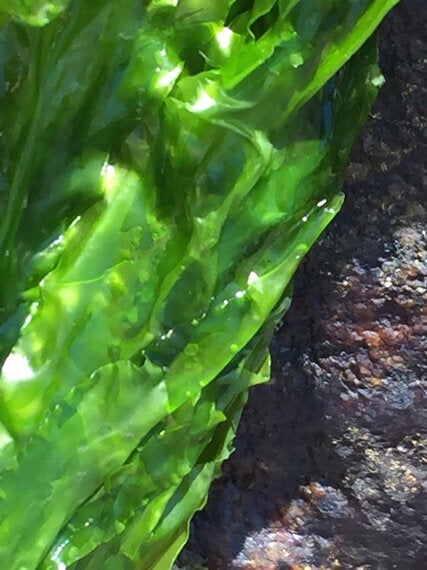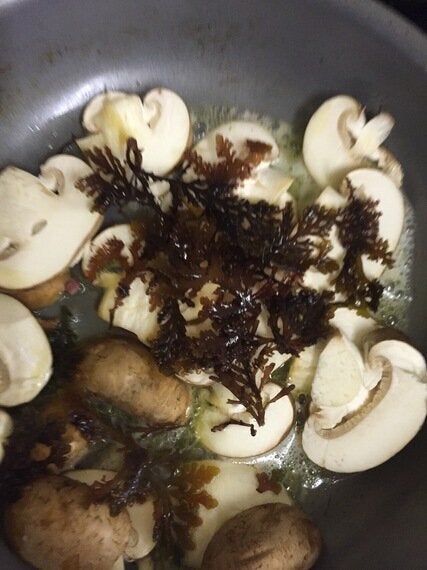
Sea Lettuce growing on St Kilda
The lacework of lochans and long white sandy beaches of the Western Isles are renowned as a haven for flora and wild life. Little however, is spoken of the magical space that reveals the ocean's seaweeds at low tide. Married to an island GP, I became acquainted with seaweed in a culinary sense, on a needs must basis. Storms and cancelled ferries limit the fresh produce on sale in the shops, and so I checked out seaweed. It was a good move. Read more in Seaweed in the Kitchen
Seaweeds are grouped by colour and different species are found in each tidal zone. Many seaweeds are kitchen chameleons- they change colour when cooked. Unlike fungi, seaweeds are not toxic, although some are tastier than others.
Carrageen Carrageen (Chondrus crispus) and Grape pip weed (Mastocarpus stellatus) are red seaweeds that can be found at low tide hanging from rocks or carpeting pebbles. If you are exploring rock pools, you will probably come across carrageen. Use scissors to cut its tiny stipes from the rock, but leave plenty to encourage regrowth. Grape pip weed is also called carrageen. It isn't smooth like Chondrus crispus but bristly and usually covered in bubbly warts. Carrageen is a setting agent that's used commercially in toothpaste, beer and ice cream. It is very useful to vegan and vegetarian cooks.
Dulse (Palmaria palmata) is a red seaweed that you'll find in deep water growing on rocks and other seaweeds (as an epiphyte). It looks like a hand with short fingers and this may be where its botanical name, Palma, comes from. Dulse has a long history of being useful to man and is probably one of the oldest foods eaten by coastal people in times of hardship.
Laver Porphyra spp is a red seaweed, although it may look green, brown, or even black. It is found on rocks in the intertidal zone. Laver can survive the wind and being out of seawater. It clings tightly to the rock as it dries and you will need to be eagle-eyed to spot it. Cut laver with scissors as the tide is coming in - the laver floats on the incoming tide and the seawater helps to wash the sand away too.
Sea lettuce looks like common-or-garden round lettuce. There are lots of species of green seaweed and they are tricky to identify correctly. They are often grouped as Ulva spp. Sea lettuce likes growing where fresh water flows into the sea, but don't pick it here. Instead, cut sea lettuce from rock pools, where there is no worry of contamination from human waste. Sea lettuce looks like laver but it's thicker and emerald green; this is why it is sometimes called green nori. It retains its colour on cooking. Laver and sea lettuce both have tiny stipes, cut them carefully to allow regrowth.
Sea spaghetti or thong weed Himanthalia elongata is well named and easily spied by children because it looks like floating pasta. It hangs from rocks at the low water mark and is attached to the rocks by a small button. This is its holdfast. It does exactly as the word suggests. Cut thongweed well below the button to ensure its future growth, and don't be greedy. When cooked this seaweed turns runner bean green. Early in the season sea spaghetti cooks in noodle time. Novice seaweed eaters might try serving sea spaghetti 50:50 with wheat pasta. Fresh thong weed is out of season now but you'll find dried in delicatessens and specialist shops.

The winter storms may be rage but at this time of year you'll still find the red seaweeds Royal Fern weed and Pepper Dulse Osmundea pinnatifida on rocks on the lower shore. The small delicate fern fronds vary in colour from red through purple to brown, depending on where it has been picked. royal fern weed Osmundea osmunda is a larger species. Pepper dulse has a tangled creeping hold, which makes it very tricky to pick sustainably - without damaging the holdfast. Chefs seek the fern seaweeds - pick and eat on the rocks and you'll understand why. I think it tastes of garlic. It has a definite kick in its after taste.
•Do not cook with storm cast or floating seaweed. Pick seaweed which is still growing - attached by its holdfast.
•Tide times vary. Ask a local fisherman or use an app. http://www.tidetimes.co.uk - a low spring tide is best.
•Take a separate bag for each species. This makes life less chaotic back in the kitchen.
•Rinse the seaweed in rock pools before popping it in bag, allowing sea residents to rehouse locally
•Identify and avoid the Desmarestia spp (which gives off sulphuric acid when cut) and pick living not storm cast seaweed, on seashore that is far from human effluence.
•Use scissors or a sharp knife to cut your seaweed and this will ensure further growth.
Follow these simple seaweed foraging rules and the coast should be clear.
Foragers should be mindful the rules of the countryside and of Dante's fourth circle - greed. Pick enough for yourself, no more and don't tug up any roots or holdfasts.
City folk can check out dried seaweeds. Use finely ground seaweed as you would a herb or spice (add some to your Christmas baking and steaming). Reconstitute larger fronds and use as a sea vegetable. Be guided by your palate. In my opinion less is more with the Ulva spp. As for the others, it's a question of taste. There are more seaweed recipes in The Forager's Kitchen